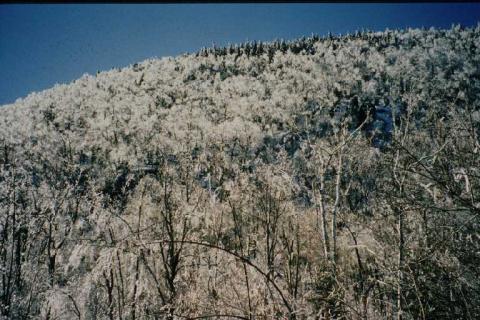Memories of the Ice Storm of 1998 and, My, How Things Have Changed

January 1998 is a time many of us will not soon forget—an unusually extensive and severe ice storm exposed nearly 25 million acres from northern New York through much of northern New England and Quebec to extreme icing. An estimated 800,000 acres saw some level of damage in New Hampshire. A map of the ice damage in the state was created using aerial survey data collected by the N.H. Division of Forests and Lands and U.S. Forest Service.
The destruction that occurred from the ice storm seemed like it would impact our forests for years to come. Tree limbs snapped sounding like rifle shots—Grafton County Extension Forester Jim Frohn recalls thinking while walking in the woods, “I’m nuts to be out here.”
Brendan Prusik, Coös County Extension Forester, on the other hand, has an image of standing on a ridge in Pittsburg, overlooking the Magalloway river valley. He was with wildlife biologist Will Staats and they surveyed the extensive damage to yellow birch and maple trees. Just about every tree had a severely broken top. Brendan says, “I was lamenting the great loss of resource. Will challenged me, saying that most of the damaged trees would soon replace their damaged crowns. I expressed doubt. We made a commitment to return in five years, to assess the longer-term effects.”
Jim Frohn agreed, saying, “I didn’t know whether to laugh or cry looking at acres and acres of stands we’d just thinned.”
It turns out that Will was right. Healthy trees saw the ice storm as a temporary setback. When Brendan and Will later returned to the site on the ridge, the trees had full crowns once again and were thriving. Only those trees with symptoms of decline before the storm suffered from the added stress. It was a good lesson in resiliency.
Brendan’s observations are borne out in the work of U.S. Forest Service researcher, Walter Shortle, who found that except for paper birch, most healthy trees survived.
All the broken trees and limbs meant many were without power for many days. Ethan Belair, the Rockingham County Extension Forester, remembers (“fondly,” he says, as he was still a youngster) being without power for 10 days. He slept next to the wood stove, pulled in snow to melt for water, and read beside a lantern. He told me, “It might run contrary to a lot of the staff who were working through that period, but I enjoyed the heck out of the storm!”
When we look back on any event after good amount of time has passed—say 20 years or so—sometimes we don’t think so much about what occurred then, but instead what has changed since.
When Karen Bennett, Extension Forester, thinks about the storm, she is reminded of how different UNH Cooperative Extension’s education and outreach methods were. In 1998, county foresters used slide shows in public meetings. Like, real slides. Remember those?! They weren’t using PowerPoint yet. Karen recalls the “worldwide web” was still in its infancy and this was the first time she used it to develop educational information on a large scale. Social media and apps didn’t exist. She told me, “Though the method of communication and the technology we used were much different then, still, hundreds of people showed up to our community meetings. And, the ’98 ice storm helped develop our response to natural disasters, no matter what technology we used. ‘Don’t Panic, Be Safe, Get Professional Help’ became our mantra.”
Forest technology has adapted, too. Jim Frohn pointed out, after the ice storm, the number of loggers using mechanized harvesting accelerated.
In 1998, I wasn’t living full-time in New Hampshire yet; I was a student at Plymouth State College and we were on winter break, so I was home in New York. But my boyfriend at the time (now husband) was working in New Hampshire for a tree crew clearing power lines. We were pretty good about talking on the phone every day or so. I heard about this big storm coming to the northeast, but it wasn’t going to hit where I was so I didn’t think much of it. I became concerned after it took a couple days before I heard from Scott. Back then, we didn’t have cell phones or email for constant communication. He still works around power lines and now, when he’s out during a storm, it’s easy to find out where he is and when he’ll be home. Back then, it was a few days before I learned just how treacherous the conditions were for him. It’s probably better that I didn’t know!
I’m starting to feel old. “Back when I was a kid, we didn’t have cell phones.” Isn’t it funny how the memories from an ice storm will bring about those kinds of thoughts? I wonder how different things will be at the 40th anniversary.
The silver lining to the ice storm of ’98 is that it gave us an unprecedented opportunity to study the long term effects of this kind of event:
- Tree Survival 15 Years after the Ice Storm of January 1998 by Walt Shortle, Kevin Smith and Ken Dudzik, USDA-Forest Service, 2014
- Tree Response Following the 1998 Ice Storm- research from USDA Forest Service, 2008
- Tree Survival and Growth Following Ice Storm Injury by Walt Shortle, Kevin Smith and Ken Dudzik, USDA-Forest Service, 2003
- Radial growth of hardwoods following the 1998 ice storm in New Hampshire and Maine by Kevin Smith and Walt Shrotle, USDA-Forest Service, 2003
- Patterns of Storm Injury and Tree Response by Kevin Smith, Walt Shortle and Ken Dudzik, USDA-Forest Service, 2001
- Ice Storm 98 Revisited- overview from 1999
- Ice Storm Project Summary- excerpt from Evaluation of Rare Plant Populations and Exemplary Natural Communities in Areas Impacted by the 1998 Ice Strom in New Hampshire
